
Description
The Neosho mucket is a freshwater clam that has a shell length of approximately four to six inches. Its shell can be described as oblong or kidney-shaped and light brown in color, though younger individuals may display greener hues. The shells of the male and female vary slightly in size and shape, with the female often being the larger of the two.
As with other mussels, the primary cause of population declines of the Neosho mucket is the construction of reservoirs and impoundments throughout its range. Direct disturbance of mussels by recreational activities also can have a negative impact on Neosho muckets. Other threats to this species include river channelization, water pollution, sedimentation, agricultural runoff, and direct disturbance of mussel beds from human activity.The Wildlife Diversity Program has funded two research and recovery grants for the Neosho mucket through ESA Section 6 funding. The first was a project conducted in 1990 by the University of Science and Arts of Oklahoma to determine the distribution and abundance of the Neosho mucket in the state. The second was a follow-up study conducted from 1994 to 1997 by the University of Oklahoma and focused on researching both the habitat preferences and status of the Neosho mucket in Oklahoma. The Peoria Tribe has partnered with Missouri State University to propagate and raise Neosho muckets in captivity for release into the Spring and Neosho rivers. The purpose of these efforts is to augment existing populations and assist in the species’ recovery across its range. Conservation agencies have an interest in the genetic diversity of this species, especially in areas where habitat has been fragmented from river damming. Genetic information from tissue samples collected as part of upcoming studies may help biologists prioritize recovery efforts.
Size
4-6 inches in length.
Habitat
The Neosho mucket was historically found throughout the Verdigris, Caney, Neosho, Spring, and Illinois rivers in Oklahoma. The largest population in the state now lies in the Illinois River. Very low numbers of Neosho muckets remain in the Neosho, Spring and Verdigris rivers upstream of impounded sections of those rivers. Neosho muckets are often found in shallow riffles, or areas of swift-moving water. In the Illinois River, Neosho muckets seem to concentrate in areas outside of the main river-channel near the shore.
Life Cycle
As with other mussels, the Neosho mucket feeds by filtering out microscopic organisms and organic particles from the surrounding water column. Little information is known regarding the reproductive ecology of this species. Similar to other species, Neosho muckets require the use of fish hosts for reproduction. Females with fertilized eggs have been found in late summer, indicating that spawning likely occurs during the spring months. Larvae must reach the gills of a host fish, usually a black bass (Micropterus sp.), to survive this stage. The female Neosho mucket uses an organ called a mantle as a lure to attract a fish host. When the bass attacks the lure, many glochidia are released and attach themselves to the gills of the fish. After several days on the host fish, the glochidia metamorphose and fall into the substrate at the bottom of the stream and grow into sedentary adults.


